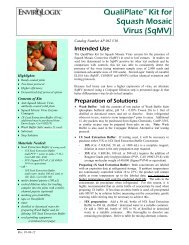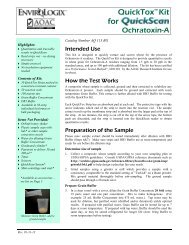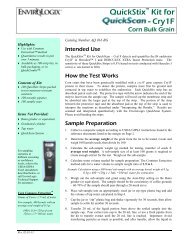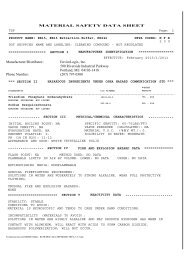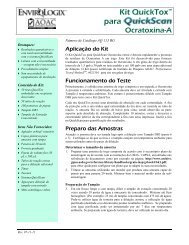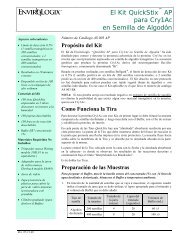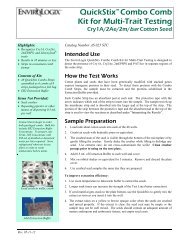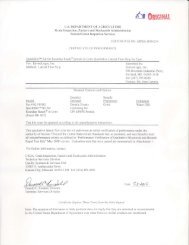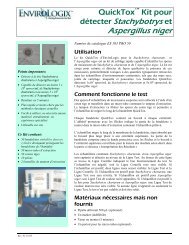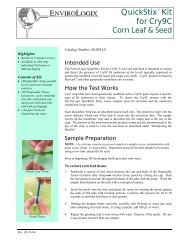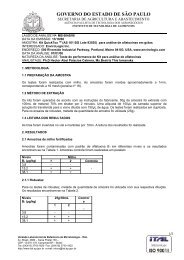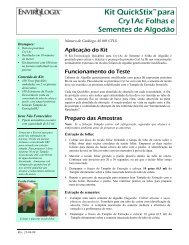Sampling Guide - Hay - EnviroLogix
Sampling Guide - Hay - EnviroLogix
Sampling Guide - Hay - EnviroLogix
Create successful ePaper yourself
Turn your PDF publications into a flip-book with our unique Google optimized e-Paper software.
Recommended Principles for Proper <strong>Hay</strong> <strong>Sampling</strong> http://alfalfa.ucdavis.edu/+producing/forage_quality/hay_sampling/HA...<br />
Recommended Principles for<br />
PROPER HAY SAMPLING<br />
[1]<br />
By D. H. Putnam, University of California, Davis<br />
Click here to begin the <strong>Sampling</strong> Certification Exam<br />
NOTE: Please read the following <strong>Hay</strong> <strong>Sampling</strong> Protocol before proceeding on to the <strong>Hay</strong> <strong>Sampling</strong> Certification<br />
Test. The UC-sponsored '<strong>Hay</strong> <strong>Sampling</strong> Certification' will enable you to self-certify your hay sample, indicating that<br />
the sample has been taken using this protocol. If you have already read and understand this protocol, you may<br />
click here to proceed directly to the hay sampling certification.<br />
INTRODUCTION<br />
Proper sampling of hay and forage is of tremendous importance to assure an accurate forage test. Remember, a<br />
lab test is only as good as the sample provided to the lab. Here’s the dilemma: Hundreds of thousands of<br />
pounds of highly variable plant material must be represented in a single, tiny, thumbnail-sized sample!! Often, the<br />
sample actually analyzed by the lab is often only ½ gram! This sample must not only represent the proper leafstem<br />
ratio and the legume/grass mix, but also reflect the spotty presence of weeds. <strong>Sampling</strong> variation is a<br />
significant problem in hay testing, and causes millions of dollars in lost revenue each year by either buyer, seller,<br />
or in animal performance. In practice, hay sampling produces more variation in results than does lab error.<br />
However, if sampling protocol is carefully followed, sampling variation can be reduced to an acceptable level, and<br />
the potential forage quality successfully predicted. The following steps have been compiled from various<br />
recommendations that have been in place for years and are widely considered to be the key elements of a<br />
standardized sampling protocol:<br />
Standardized Protocol to assure a representative sample of hay.<br />
1. Identify a single ‘lot’ of hay. This is a key first step to proper hay sampling, and one frequently ignored. A<br />
hay lot should be identified which is a single cutting, a single field and variety, and generally be less than<br />
200 tons. Combinations of different lots of hay cannot be represented adequately by a forage sampling<br />
method; different lots should be sampled separately. Don’t mix cuttings, fields, or hay types.<br />
2. When to Sample? It is important to sample the hay either as close to feeding, or as close to point of sale as<br />
possible. Dry matter measurements are especially subject to changes after harvest and during storage, but<br />
other measurements may also change. <strong>Hay</strong> immediately after harvest normally goes through a process of<br />
further moisture lost known as a ‘sweat’. During this period, hay may heat up due to the activities of<br />
microorganisms, driving residual moisture from the hay. Thus, moisture content is likely to be reduced in<br />
the days and weeks after harvest. If the hay has been baled at excess moisture, further biological activity<br />
may result in molding, or even (under very high moisture conditions) spontaneous combustion of hay.<br />
However, after hay has equilibrated to the range of 90% DM (10% moisture, depending upon humidity), it<br />
is typically quite stable. ‘As received’ dry matter measurements should be used to adjust quantity<br />
(tonnage, yield), not quality parameters, which should be compared on 100% DM basis.<br />
3. Choose a sharp, well-designed coring device. Use a sharp coring device 3/8-3/4” diameter. Never send in<br />
flakes or grab samples, it is nearly impossible for these samples to represent a hay lot. “Hand-grab’<br />
samples have been shown to be significantly lower in quality than correctly sampled forage. The corer<br />
should have a tip 90 o to shaft, not angled—studies have shown that angled shafts push aside some<br />
components of hay, providing a non-representative sample of the entire mix. Very small diameter tips<br />
( 24”) provide good samples, but give too much forage in a 20 probe composite sample—thus the
Recommended Principles for Proper <strong>Hay</strong> <strong>Sampling</strong> http://alfalfa.ucdavis.edu/+producing/forage_quality/hay_sampling/HA...<br />
sampler may stop before 20 cores are completed or the lab may not grind the whole sample (see below). The<br />
length of probe should allow probing to a depth of 12”-24”. Studies have shown this depth to successfully<br />
characterize the variation in hay, even in large (1 ton) bales, and no significant differences were seen<br />
between a 32” and 12” probe. A range of probe tip designs have been used successfully, from serrated to<br />
non-serrated tips—it is probably most important that the tip be sharp (and maintained sharp), and not<br />
create ‘fines’ during the cutting action, but cleanly cut across a cross-section of hay. Some probes are<br />
power, hand-brace, or auger driven, whereas others are push-type, both of which may work well. Many<br />
(not all) probes can be used to successfully represent a hay lot as long as they follow these principles: they<br />
easily penetrate the bale, fairly represent the leaf-stem ratio, can be easily sharpened, and produce<br />
approximately ½ lb (200 g) of sample in about 20 cores to a depth of 12”-24”. See a listing of probes at<br />
NFTA website.<br />
4. Sample at random. The sampler should walk around the stack as much as possible, and sample bales at<br />
random. Both ends of bales should be sampled by walking around the stack. This is sometimes difficult<br />
since all of the bales are not available to the sampler (they may be against walls of a barn or up too high for<br />
practical sampling). However, the sampler should make every attempt to sample in a random fashion—this<br />
means not to bias either for or against any bales in the stack. For example, the sampler may walk 15<br />
steps, sample, walk 20 steps, sample, walk 5 steps, sample, while walking around stack—trying to<br />
represent all areas of the stack. Don’t avoid or choose bales because they look especially bad or good--If<br />
20 cores are taken, they won’t make much difference anyway. Avoiding or choosing bales introduces bias.<br />
5. Take enough cores. We recommend a minimum of 20 cores for a composite sample to represent a hay lot.<br />
This is the same for large (e.g. 1 ton bales), or small 2-tie or 3-tie bales. This is because core-core (and<br />
bale-bale) variation in forage quality is tremendous (e.g. 5-7 % points ADF or CP). <strong>Sampling</strong> a large<br />
number of locations and bales throughout the stack to create a composite sample is a key aspect of<br />
representing the full variation contained in a hay lot. It is recommended to take more than 20 cores (e.g.<br />
up to 35) with very large lots (100-200 tons), or with highly variable lots (e.g. lots that may have nonattached<br />
leaves or are from very weedy fields). With small bales, sample 1 core per bale, >20 bales; with<br />
larger (e.g. 1 ton) bales, take 2-3 cores per bale in the center of the ends, sampling >10-12 bales. A larger<br />
number of core samples is generally better at characterizing variation in hay in more variable hay lots.<br />
6. Use proper technique. Sample butt ends of hay bale, between strings or wires, not near the edge. Probe<br />
should be inserted at 90 o angle, 12”-18” deep. Do not sample in the same exact spot twice. Do not use<br />
any technique which is likely to misrepresent the leaf-stem ratio. The sides or the top of the bale should<br />
not be sampled, since these cores will only represent one flake from a single area of the field, and<br />
additionally misrepresent the leaf-stem ratio. With round bales, sample towards middle of bale on an angle<br />
directly towards the center of the bale.<br />
7. Sample amount: “not too big, not too small”. <strong>Sampling</strong> should be done so that about ½ lb of sample is<br />
produced. Too-small samples don’t fairly represent the full range of variation in the hay lot. Very big<br />
samples (common with large length or diameter probes) are excellent at representing the hay but have<br />
practical disadvantages. Large samples cannot be easily ground by the labs—many labs will simply subsample<br />
such large samples before grinding, defeating the entire purpose of good sampling technique! The<br />
sampler should ensure that the entire sample is ground by the lab—this is important to check. If your lab is<br />
not grinding the whole sample, ask why—it could be that your sample is too large. Only work with labs that<br />
are willing to grind the entire sample (after a DM sample for field DM is taken). But you should also assure<br />
that you are providing a reasonable ½ lb sample, so that it can be practically handled by the lab. If a<br />
probe is too big or small to produce about ½ pound in 20 cores—get a different one! (see list of probes on
Recommended Principles for Proper <strong>Hay</strong> <strong>Sampling</strong> http://alfalfa.ucdavis.edu/+producing/forage_quality/hay_sampling/HA...<br />
NFTA website)<br />
8. Handle samples correctly. Seal Composite 20-core sample in a well-sealed plastic bag and protect from heat.<br />
Double bagging is beneficial, especially for DM measurements. Deliver to lab as soon as possible. Do not<br />
allow samples to be exposed to excess sun (e.g. in the cab of a pickup truck). Refrigeration of hay samples<br />
is helpful, however, dry hay samples (about 90% DM) are considered fairly stable.<br />
9. Never split samples without grinding. It is important to occasionally double check the performance of your<br />
lab by comparing with another (or several other) labs. However, never split un-ground samples and send<br />
them to two different labs—the samples are likely to be genuinely different! To test two labs, either grind<br />
and carefully split the sample, or better yet, ask for your ground sample back to send to another lab. Use<br />
several samples to test average potential bias between labs. Don’t work with labs that are unwilling to do<br />
this—good labs should be wiling to test their performance and answer questions with regards to consistency<br />
of lab results. Ask for their NFTA results!<br />
10. Choose an NFTA-Certified Lab. The first step in choosing a high-quality hay testing lab is to determine<br />
whether they participate in the NFTA proficiency certification program. The National Forage Testing<br />
Association, a volunteer group set up by hay growers, sends blind samples to labs, and they must match<br />
the true mean within an acceptable range of variation. NFTA labs have demonstrated their commitment to<br />
good results, are more likely to be interested in accuracy. Additionally, programs such as California’s<br />
‘California Recognized’, the Midwest NIRS consortium, or other voluntary proficiency programs provide an<br />
additional opportunity for labs to prove their proficiency. However, these programs only work if the<br />
clientele (you) pays attention to them. Choose a lab that chooses EXCELLENCE! Choose an NFTA lab (see<br />
www.foragetesting.org for a listing of NFTA-certified labs) !<br />
11. NOTE: If you have understood this protocol, please proceed on to the <strong>Hay</strong> <strong>Sampling</strong> Certification Test. The UCsponsored<br />
'<strong>Hay</strong> <strong>Sampling</strong> Certification' will enable you to self-certify your hay sample, indicating that the<br />
sample has been taken using this protocol.<br />
[1]<br />
Dan Putnam, Extension Agronomist, Department of Agronomy and Range Science, University of California, Davis 95616, http://alfalfa.ucdavis.edu/<br />
Email: dhputnam@ucdavis.edu. This protocol has evolved as a set of recommendations over many years by experienced agronomists from California<br />
and many other states, and from field experimentation. Although there may be slight variations from region to region, and some differences in opinion<br />
about particular points, this protocol is likely to be very close to methods recommended throughout the United States.



